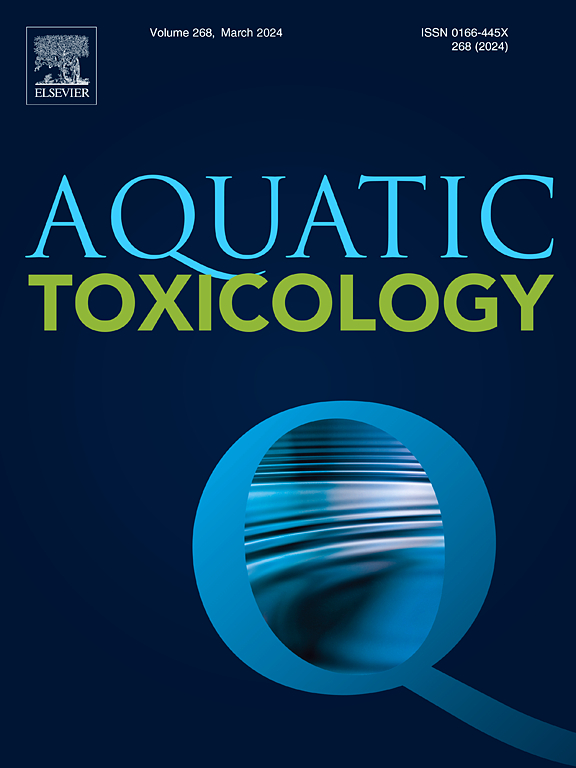Oxidative stress and mitochondrial dysfunctions induced by cyanobacterial microcystin-LR in primary grass carp hepatocytes
IF 4.1
2区 环境科学与生态学
Q1 MARINE & FRESHWATER BIOLOGY
引用次数: 0
Abstract
Microcystin-LR (MC-LR), a cyclic heptapeptide produced by freshwater cyanobacteria, induces a range of liver injuries. However, the mechanisms underlying MC-LR toxicity in primary hepatocytes of aquatic organisms remains poorly understood. In this study, we investigated the effects of MC-LR on oxidative stress and mitochondrial function using primarily cultured grass carp hepatocytes. The results revealed that IC50 of MC-LR on grass carp primary liver cells for 24 hours was 2.40 μmol/L. Based on 24h-IC50, concentrations of 0, 0.30, 0.60, and 1.20 μmol/L were used in subsequent experiments. MC-LR exposure led to a significant reduction in cell viability, induced abnormal cell morphology, and caused plasma membrane rupture, as indicated by elevated LDH activity in a concentration-dependent manner. Additionally, MC-LR exposure induced oxidative stress, resulting in increased ROS levels and downregulation of genes associated with oxidative stress, including keap1, nrf2, cat, sod1, gpx, gst, and gr (P<0.05). Furthermore, the electron microscopy results showed that MC-LR caused damage to the ultrastructure of primary hepatocytes, including mitochondrial membrane rupture, vacuolation, and induction of mitochondrial autophagy. Moreover, MC-LR exposure elevated intracellular Ca2+ concentration, reduced MMP and ATP levels, and inhibited mitochondrial respiratory chain complex I activity (P<0.05). qRT-PCR analysis demonstrated that MC-LR treatment significantly decreased the transcriptional levels of genes related to mitochondrial quality control including pgc-1α, tfam, nrf1, drp1, opa1, mfn1, and mfn2 (P<0.05). Collectively, our findings highlight that MC-LR causes oxidative stress and impairs mitochondrial function, leading to further hepatocyte damage, which provides insights into the mechanisms of MC-LR-induced hepatotoxicity and offers valuable references for further investigations.

蓝藻微囊藻素- lr诱导草鱼原代肝细胞氧化应激和线粒体功能障碍
微囊藻毒素- lr (MC-LR)是淡水蓝藻产生的一种环七肽,可引起一系列肝脏损伤。然而,水生生物原代肝细胞中MC-LR毒性的机制仍然知之甚少。在这项研究中,我们研究了MC-LR对草鱼肝细胞氧化应激和线粒体功能的影响。结果表明,MC-LR对草鱼原代肝细胞作用24 h的IC50为2.40 μmol/L。以24h-IC50为基础,分别采用0、0.30、0.60、1.20 μmol/L的浓度进行后续实验。MC-LR暴露导致细胞活力显著降低,诱导细胞形态异常,并引起质膜破裂,LDH活性以浓度依赖的方式升高。此外,MC-LR暴露诱导氧化应激,导致ROS水平升高和氧化应激相关基因下调,包括keap1、nrf2、cat、sod1、gpx、gst和gr (P<0.05)。电镜结果显示,MC-LR对原代肝细胞超微结构造成损伤,包括线粒体膜破裂、空泡形成和诱导线粒体自噬。此外,MC-LR暴露可提高细胞内Ca2+浓度,降低MMP和ATP水平,抑制线粒体呼吸链复合体I的活性(P<0.05)。qRT-PCR分析显示,MC-LR处理显著降低了线粒体质量控制相关基因pgc-1α、tfam、nrf1、drp1、opa1、mfn1和mfn2的转录水平(P<0.05)。总之,我们的研究结果强调MC-LR引起氧化应激并损害线粒体功能,导致进一步的肝细胞损伤,这为MC-LR诱导的肝毒性机制提供了新的见解,并为进一步的研究提供了有价值的参考。
本文章由计算机程序翻译,如有差异,请以英文原文为准。
求助全文
约1分钟内获得全文
求助全文
来源期刊

Aquatic Toxicology
环境科学-毒理学
CiteScore
7.10
自引率
4.40%
发文量
250
审稿时长
56 days
期刊介绍:
Aquatic Toxicology publishes significant contributions that increase the understanding of the impact of harmful substances (including natural and synthetic chemicals) on aquatic organisms and ecosystems.
Aquatic Toxicology considers both laboratory and field studies with a focus on marine/ freshwater environments. We strive to attract high quality original scientific papers, critical reviews and expert opinion papers in the following areas: Effects of harmful substances on molecular, cellular, sub-organismal, organismal, population, community, and ecosystem level; Toxic Mechanisms; Genetic disturbances, transgenerational effects, behavioral and adaptive responses; Impacts of harmful substances on structure, function of and services provided by aquatic ecosystems; Mixture toxicity assessment; Statistical approaches to predict exposure to and hazards of contaminants
The journal also considers manuscripts in other areas, such as the development of innovative concepts, approaches, and methodologies, which promote the wider application of toxicological datasets to the protection of aquatic environments and inform ecological risk assessments and decision making by relevant authorities.
 求助内容:
求助内容: 应助结果提醒方式:
应助结果提醒方式:


